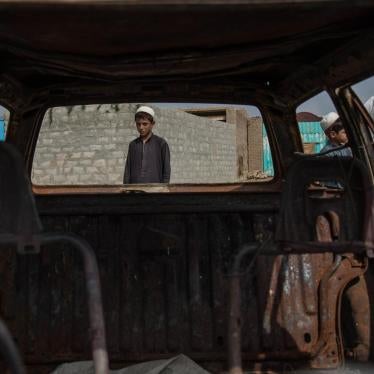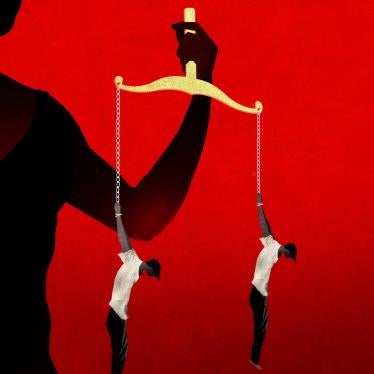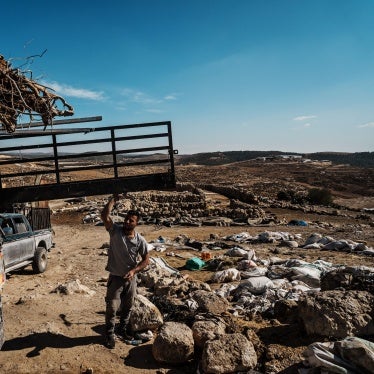On April 23, 2013, the US Senate Committee on the Judiciary, Subcommittee on the Constitution, Civil Rights, and Human Rights held a hearing entitled “Drone Wars: The Constitutional and Counterterrorism Implications of Targeted Killing”. Letta Tayler, Senior Researcher in the Terrorism/Counterterrorism Division submitted the following testimony for the record.
--------
Chairman Durbin, Ranking Member Cruz, and other members of the subcommittee, thank you for the opportunity to submit a statement for today’s hearing on targeted killings. My name is Letta Tayler and I am the senior terrorism and counterterrorism researcher at Human Rights Watch, an independent organization dedicated to promoting and protecting human rights around the globe. From February 2011 to February 2013, I also was our organization’s lead researcher on Yemen, the geographic base of Al Qaeda in the Arabian Peninsula (AQAP), which the Obama administration views as one of the most serious threats to US national security. I have visited Yemen four times in the past year and interviewed scores of Yemenis about their security concerns, including US targeted killings on Yemeni soil.
My written testimony will focus on an air strike in central Yemen in September 2012 that killed 12 civilians but not the apparent target, who was not even nearby. My findings on that attack were published in December 2012 in Foreign Policy.[1] The attack serves as a case study of the perils, both legal and strategic, of the US insistence on cloaking its targeted killing program in secrecy. Not only is the US government failing to fully acknowledge civilian deaths in targeting operations, but its failure to do so is alienating local populations.
Air Strike Kills 12 Civilians
The attack took place outside of Radaa, a hilltop city 100 miles southeast of Yemen’s capital, Sanaa, in an area largely outside the central government’s control. In January 2012, al Qaeda militants seized Radaa and held it for 10 days until local sheikhs chased them out. Many of the militants retreated into nearby villages. Since that time, US aerial drones and US or Yemeni warplanes reportedly carried out at least 10 deadly strikes on alleged Islamist militants in Radaa and surrounding hamlets, and surveillance drones have circled the area daily.
Shortly after 4 p.m. on September 2, 2012, a manned warplane or a drone struck a sport utility vehicle traveling north from Radaa along an isolated road. Quoting unnamed Yemeni officials, local and international mediainitially described the victims as “al Qaeda militants.” But after relatives of the victims threatened to bring their loved ones’ charred bodies to the doors of Yemen’s president, the country’s official news agency, Saba, called the strike an “accident” and admitted the awful truth: The 12 people killed were civilians. One victim was a pregnant woman. Three were children.
In December 2012, The Washington Post published a report quoting unnamed US officials in Washington as saying a US military aircraft, “either a drone or a fixed-wing airplane,” fired on the vehicle.[2] Seven months later, that sentence remains the only US admission of responsibility for the attack, despite requests for comment from international media and nongovernmental organizations including Human Rights Watch.
During a research trip to Yemen last September and October, I interviewed four witnesses whose relatives and friends were among those killed in the strike, as well as several Yemeni human rights activists and lawyers who had investigated the incident. I also reviewed videos and photos of the scene taken immediately after the attack.
All 12 victims were residents of Sabool, a cluster of 120 brick-and-mud homes six miles north of Radaa that, according to residents and local journalists, has no electricity, no paved roads, no schools, and no hospitals. The only livelihood in Sabool is farming for qat, a narcotic leaf that is legal and widely chewed in Yemen.
All morning and afternoon on September 2, two drones had been circling over Sabool, the witnesses told me. Shortly before 4 p.m., three of the witnesses said, two warplanes also swooped into the area.
“I heard a very loud noise, like thunder,” said Sami al-Ezzi, a farmer who was working in his fields in Sabool. “I looked up and saw two warplanes. One was firing missiles.”
Rushing to the scene, about 1½ miles from Sabool, residents found a horrific sight: the battered Toyota Land Cruiser that had served as the daily shuttle service between Sabool and Radaa lay on its side in flames. Charred bodies that had been flung from the vehicle lay on the road, dusted with white powder—flour and sugar, the witnesses said, that the victims were bringing home from market when the aircraft attacked.
“About four people were without heads. Many lost their hands and legs," said Nawaf Massoud Awadh, a sheikh from Sabool who was among the first to arrive at the scene. “These were our relatives and friends.”
Two victims were a mother and daughter, clutched in a lifeless embrace. “The bodies were charred like coal. I could not recognize the faces,” said Ahmed al-Sabooli, a 22-year-old farmer. Moving in closer, Sabooli realized that the woman and daughter were his mother and 10-year-old sister, and that his father also was among the dead. “I recognized my mother because she was still holding my sister in her lap,” Sabooli said. “That is when I cried.”
Seven of those killed were breadwinners; in Sabooli’s family alone, six of his siblings are too young to fend for themselves. Yet the families of the victims have received no compensation, much less a public apology, from the US government. “Now we have 50 people in our village with no one to care for them,” sheikh Awadh told me. “Who will raise them? Who will educate them? Who will take care of their needs?”
The videos depicted chaos at the scene.
“Push! Push!” “Open the door!” residents are heard shouting in one video. Seeking to extinguish the flames, they urged, “Bring sand!”
Two men in the video are heard exclaiming that a warplane with “two exhausts in the back" -- presumably twin engines -- fired munitions at the vehicle while other aircraft were circling. The men's agitated exchanges underscore the uncertainty in Yemen over who is conducting such attacks.
“It's our government, it's our government,” one man says.
“It's America, it's America,” the other responds.
One video shows a man pulling a Kalashnikov assault rifle from the wreckage and throwing it aside. This may seem incriminating, but Yemen is among the world’s most armed countries, and it is common for men to carry assault rifles in tribal areas such as Sabool and Radaa.
The group of villagers was returning home from the local market town. Sabooli's mother, for example, had gone to Radaa with her husband for a doctor’s appointment; they had brought their daughter along for the ride. Most of the other passengers were farmers who had gone to Radaa to sell their crops.
Targeted Militant Not in Vehicle
Local and international media quoted unnamed Yemeni government officials as saying the attack's intended target was Abdulraouf al-Dahab, an alleged al Qaeda militant whose brother had led the January takeover of Radaa. Dahab is from Manasseh, a village about nine miles north of Radaa. The SUV was struck as it approached an intersection where one road led to Sabool and the other to Manasseh. But Dahab was not inside the Land Cruiser or anywhere in sight. Several subsequent drone strikes have reportedly failed to kill Dahab.[3]
Evidence from the site does not clarify whether the villagers were killed by a drone or a fighter jet, or what role the Yemeni authorities may have played in the strike. Two witnesses told me they saw the warplanes fire munitions that they thought were bombs and missiles. Two other witnesses told me they saw a black tail fin near the burning SUV, and that would-be rescuers used it to try to ram open a door of the vehicle. A black tail fin is typical of a Hellfire, a US missile that can be fired by either drones or fighter jets. The shrapnel that witnesses brought me from the site is more consistent with the type of damage caused by a bomb -- which would point to an attack by manned jets.
Initial media reports quoted Yemeni officials as saying Yemeni warplanes carried out the attack. But, as a 2010 US diplomatic cable released by Wikileaks reveals, Yemen has previously covered up for US targeted killings gone awry. According to the cable, then-President Ali Abdullah Saleh told Gen. David Petraeus, who was then the head of US Central Command, that “We'll continue saying the bombs are ours, not yours.”[4] The two officials were discussing a US air strike in December 2009 that killed 41 civilians in southern Abyan province.
The Obama administration maintains that the United States has authority under both domestic and international law to conduct targeted killings because the country is at war with al Qaeda and its affiliates. International law permits targeted killings of enemy fighters in battle zones and of people posing an imminent risk to life in law enforcement situations.[5] However, US officials have failed to explain how they make this determination in areas that are far from a traditional battlefield.
John Brennan, who was President Obama’s chief counterterrorism advisor until his confirmation as Central Intelligence Agency director in March, has said that civilian casualties during targeted killings are “exceedingly rare.”[6] But, citing national security, US officials from President Obama on down have refused to disclose how many militant suspects and civilians have been killed, or the legal basis for placing suspected militants on a “kill list.” Nor will the Obama administration provide information on what steps it takes to minimize civilian casualties or investigate attacks in which civilians are killed.
Scant Redress
Governments have an obligation under international law to investigate alleged violations of the laws of war and provide redress for unlawful attacks. In Afghanistan, NATO members -- including the United States -- have recognized the value of compensating civilians for loss of life or other damage, even when the attacks are lawful.
There is no such formal system in Yemen. Indeed, the relatives of those killed on September 2 have fought an uphill battle to gain even the most meager assistance. Distraught relatives and friends had to collect the charred remains of the victims by themselves and drive them to the city morgue in Radaa. Upon reaching the outskirts of the city, troops from the elite Republican Guard blocked their entry for two hours. Then officials at the morgue refused the bodies.
The Sabool villagers spent the night on the streets of Radaa, fending off stray dogs from the corpses spread out on the beds of pickup trucks. The next day, Radaa shopkeepers joined the Sabool residents in blocking the city’s main street and threatening to bring the decomposing bodies to the doorstep of President Abdu Rabu Mansour Hadi, who was installed in 2012 with US support and is an outspoken proponent of the targeted killing program.
Within hours, Sheikh Sinan Garoon, the deputy governor of al-Bayda, the province that includes Radaa and Sabool, arrived to pay off victims’ relatives the tribal way, with 95 Kalashnikovs and a total of 15 million Yemeni rials -- about $70,000 -- in burial money. He also promised further compensation, villagers said. “We will give you the guns,” Deputy Governor Garoon is seen telling the angry demonstrators in a video obtained by Human Rights Watch. “If you demand blood money, it will be given to you.”
In Sanaa, President Hadi announced he would create a special committee to investigate the Radaa attack. But to date the panel has not been formed, and talks on compensation beyond the initial $70,000 have stalled. “They were toying with us,” sheikh Awadh told me bitterly.
Deputy Governor Garoon told the relatives of those killed that “the government is busy nowadays with more important issues,” Sabooli said. “It's as if we live in a jungle and the attack was on wild animals -- no one cares.”
Meanwhile, the family of Abdulraoud Dahab, the militant reportedly targeted in the strike, has offered financial assistance to families around Radaa who have lost relatives in targeted killing operations, residents told me.
US Drone Strikes Began in Yemen
Yemen, the poorest country in the Middle East, has a history with what the George W. Bush administration called the “global war on terror.” The Arabian country is not only the base of Al Qaeda in the Arabian Peninsula, it also is the ancestral homeland of Osama bin Laden. The strategic Yemeni port of Aden was the site of al Qaeda’s suicide bombing of the naval vessel USS Cole that killed 17 American sailors in 2000.
In 2002, Yemen became the first country in which the US used a drone strike in a targeted killing. That attack killed alleged al Qaeda leader Qaed Salim Sinan al-Harethi, along with five other suspected militants. The United States carried out its next targeted killing in Yemen in 2009 and to date has carried out at least 53 drone strikes and other air attacks there, killing upwards of 300 people, according to the London-based Bureau of Investigative Journalism.[7] But lack of access to the attack areas, nearly all of which are too dangerous for international media and investigators to visit, makes it impossible to verify the totals or to determine how many of those killed were civilians, and under what circumstances. The same difficulty exists for verifying casualties from US targeted killings in Pakistan and Somalia.
The United States also has provided at least $290 million in security assistance to Yemen since 2006, most of it for counterterrorism—far more per year than in non-security aid.[8]
The intense US counterterrorism activity in Yemen, combined with an official wall of silence when civilians are killed in targeted killings, has led many Yemeni citizens to conclude that the US views their country only through a security prism and cares nothing for the well-being of its people. This view gained additional currency during Yemen’s largely peaceful uprising against then-president Saleh in 2011; US officials had viewed Saleh has a critical if fickle counterterrorism ally and initially appeared reluctant to support his resignation.
In 2012, after Saleh resigned from the presidency, the US government for the first time began providing more economic and humanitarian assistance than covert security aid to Yemen--$198 million compared to $158--in counterterrorism and other security assistance.[9] But for those civilians affected by the US targeted killing policy, no amount of humanitarian assistance is likely to change minds.
Need for Transparency, Accountability
The US needs to come clean about whom it is killing in Yemen and other countries where it is carrying out targeted killings. It should ensure its rulebook complies with international law, including the obligation to investigate alleged unlawful attacks, hold to account those responsible for unlawful attacks, and provide adequate redress to those it has wrongfully killed. The Obama administration is reportedly poised to shift command of targeted killings from the CIA to the military; while this is one important step, it is not enough. Most strikes in Yemen, for example, are carried out by the Pentagon’s Joint Special Operations Command, often with CIA input, yet they are cloaked in as much or almost the same level of secrecy and lack of accountability as strikes in Pakistan that are carried out by the CIA.
With neither Yemeni nor US authorities taking responsibility for targeted killings that go wrong, Yemenis I spoke with blame both countries. As Sabooli, the farmer who lost his parents and little sister in the strike outside Radaa told me: “Both the Yemeni government and the American government killed my family and my villagers. Both of them should be brought to justice.”
[1] See “Anatomy of an Air Strike Gone Wrong,” Foreignpolicy.com, December 26, 2012, https://www.hrw.org/news/2012/12/26/anatomy-air-attack-gone-wrong.
[2]Sudarsan Raghavan, “When U.S. drones kill civilians, Yemen’s government tries to conceal it,” The Washington Post, December 24, 2012, http://www.washingtonpost.com/world/middle_east/when-us-drones-kill-civilians-yemens-government-tries-to-conceal-it/2012/12/24/bd4d7ac2-486d-11e2-8af9-9b50cb4605a7_story_1.html.
[3] See, for example, Iona Craig, “Yemen Tribesmen Reportedly in Angry Protest Over Drone Campaign,” Times of London, January 5, 2013, http://www.thetimes.co.uk/tto/news/world/middleeast/article3648934.ece.
[4] “General Petraeus' Meeting With Saleh On Security Assistance, Aqap Strikes,” US Embassy Cable, January 4, 2010,
[5]See Human Rights Watch, Q & A: US Targeted Killings and International Law, December 19, 2011, https://www.hrw.org/news/.../q-us-targeted-killings-and-international-law.
[6]US Select Committee on Intelligence, Responses to Pre-Hearing Questions, Nomination of John O. Brennan to be the Director of the Central Intelligence Agency, February 7, 2013, intelligence.senate.gov/130207/prehearing.pdf
[7]See The Bureau of Investigative Journalism’s “Covert Drone War” web page, http://www.thebureauinvestigates.com/category/projects/drones/.
[8] “Yemen: Background and US Relations,” Congressional Research Service, November 2012, https://www.fas.org/sgp/crs/mideast/RL34170.pdf, p. 15.
[9]“U.S. Assistance to Yemen,” US State Department fact sheet, March 7, 2013, http://www.state.gov/r/pa/prs/ps/2013/03/205816.htm.





